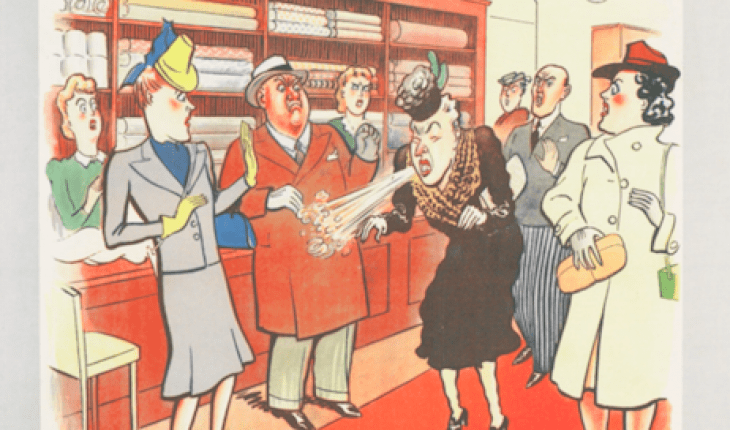Dig for Victory, Measles is Misery, Don’t Die of Ignorance; over the past century, these public health messages have frightened, inspired and educated the British public. Opening on 23 October, at the Museum of Brands, in London these catchy slogans will be remembered in ‘Can Marketing Save Lives? A century of Public Health Marketing,’ an interactive exhibition looking back on a century of public health marketing campaigns. Duncan Selbie, Chief Executive, Public Health England comments, ‘We have brought together public health marketing campaigns from the last century, which shows just how much has changed in the last 100 years. Powerful communications and effective marketing campaigns are instrumental in delivering government policy and helping to encourage behaviour change.’
The exhibition traces the role of marketing in the history of public health and explores the enduring power of such communications to effect change. Incorporating over 100 posters, TV commercials, and objects, it will revisit historical events such as the founding of the NHS, the first vaccination programmes, and the campaign for AIDS awareness as well as asking what public health marketing may hold for the future.
The exhibition traces the role of marketing in the history of public health and explores the enduring power of such communications to effect change. Incorporating over 100 posters, TV commercials, and objects, it will revisit historical events such as the founding of the NHS, the first vaccination programmes, and the campaign for AIDS awareness as well as asking what public health marketing may hold for the future.
Selbie adds: ‘Public health marketing campaigns help to save lives and as we look to the future we will continue to develop our partnerships to create campaigns that help protect and improve the health of the next generation’.
On display visitors will see historical posters, TV commercials, and objects that span a century of public health marketing – including campaigns for food rationing, the launch of the NHS, the first vaccinations, smoking legislation, AIDs awareness, and new digital technologies. Together, they demonstrate the persuasive power of effective marketing.
The past 100 years are divided into five historical eras; Fighting Fit, War to Welfare, Age of Aspiration, Age of Fear and Age of Participation. The exhibition also asks what the future may hold for public health marketing.
There is nothing new about health messages: Pharmaceutical advertising originates from the 19th century when door-to-door itinerant, unregulated peddlers – the proverbial ‘cure for everything’ salesmen – sold patent medicines directly to consumers. In those days newspapers had far more freedom to print whatever adverts they liked and adverts written in overblown language promised to cure everything from piles to spots and cancer. With echoes of some reaches of the internet today, these dubious salesmen often sought to sow seeds of doubt about the efficacy of trained doctors, plugging their own doubtful ‘cures’ as more effective than professional medical care.
In a world long before the internet, some extraordinary products made their frequently dodgy, if undoubtedly imaginative, inventors rich. One such inventor was Lydia E. Pinkham, who in 1875 launched her ‘Vegetable Compound’ and made a fortune after placing ads in newspapers promising to treat a collection of “female” problems which appealed to readers who couldn’t reach for Ibuprofen, as it hadn’t been manufactured. Pinkham marketed her ‘Vegetable Compound’ as a concoction “invented by a woman and prepared by a woman” and packaged it to appeal to women and the product made her a fortune by the beginning of the 20th century.
Over the past century individuals’ emotions and behaviour with regards to their health has been consciously and subconsciously influenced for the better and the worse by advertising, marketing communications, leafleting and marketing campaigns. In addition to public health announcements and mass media advertising, messages are placed on product labels and in television shows and social media. Research indicates that these health related messages can positively influenced people’s behaviour towards their health and nutrition. Some communications improve health by discouraging unhealthy or risky consumption, such as smoking and excessive drinking, others do the opposite.
An accompanying programme of talks will run alongside the show which will explore how PHE marketing has impacted on people’s lives, from saving lives to social and cultural effects of the campaigns.
Public Talks Programme:
- 3rd Dec, 6.30 – 9pm: Nudge, Shove or Shock? 100 Years of Public Health & Safety Messages
Alex Aiken, Executive Director of Government Communications, will examine the history of Public Health & Safety messages, the successes of campaigns and their efforts to ‘Nudge, Shove, or Shock’ the British public. - 21st Jan, 6.30-9pm: A World Without Brands – Why It Wouldn’t Work
Rory Sutherland, Vice Chairman of Ogilvy UK, will argue the case for the vital role brands play in our society. For too long economic rationalists have underestimated the role of brands – hear Rory’s insights into how brands are the key to an effective economy. - 21st Feb, 6.30 – 9pm: How Partnership Marketing Could Be Used to Promote Public Health
Jane Asscher, CEO and Founding Partner at 23red will explore the importance of collaboration in producing an effective public health campaign. - 4th April, 6.30 – 9pm: Marketing Health – not for the faint-hearted Jo Arden, CSO, MullenLowe
- 7th March , 6.30 – 9pm: Tim Duffy, Chairman, Saatchi
- Banishing Blue Monday vibes at the London Art Fair - 21st January 2024
- The Credit Suisse Exhibition: Frans Hals - 7th January 2024
- “Winter Flowers Week” opened by Her Majesty The Queen (Camilla) - 10th December 2023






